Article content
The water was like glass.
Advertisement 2
Article content
Here at the north end of Pine Coulee Reservoir, down in the valley where a tiny creek used to run, the water that still remained after last summer’s heat lay still. The cattle grazing on the pasture beside it reflected on a surface barely ruffled by the light breeze just starting to stir. Way up at the far end, a pair of geese let out the occasional honk but other than that, it was quiet enough that I could hear the wingbeats of a pair of ravens that flew by overhead.
Article content
The warm weather of the past week had left the shallow water ice-free and the final traces of the snow that had blanketed the countryside back in October were confined to the deepest shadows on the coulee slopes. It had rained overnight and the roads were muddy enough that when I pulled over to shoot a couple pictures, my wheels spun on the slick when I started back up again.
Advertisement 3
Article content
Up on the flats above the reservoir the air was hazy and when I put up my little drone over a field of not-yet-baled feed grain I could barely see back toward Nanton through the thin mist. But it gave the light a nice, soft glow.
The morning wasn’t all that different from the last time I’d been down this way two months before. It was a little chillier, though not by much, and the leaves that had just been starting to turn colour were now almost entirely gone. But, otherwise, it felt nearly the same.
If there was anything different, though, it was the amount of water in the reservoir.

Pine Coulee Reservoir has been quite low for the last few years and it was really down the last time I was here. That wasn’t too much of a surprise, though. It was a pretty summer and reservoirs do tend to fluctuate quite a bit even in the wettest years.
Article content
Advertisement 4
Article content
But just recently I saw a video from one of my favourite YouTubers showing an afternoon of fishing on the reservoir and he seemed shocked the water was so low. Now, looking south across what used to be a shallow wetland, I could see he wasn’t exaggerating.
This wetland hasn’t been wet for years now but looking toward the dam-end of the coulee, I could see the dryness had expanded. But it wasn’t until I parked at the mid-point of the reservoir that I could really see by how much.

Under the chinook clouds that had rolled in and with the blue shoulders of the Porcupine Hills rising to the south, I could see the water had dropped a lot since I was last here. I remembered the terraced shoreline from before, the series of steps that marked where the waves had lapped descending down to the present water level. But now, it seemed, the steps had descended even more.
Advertisement 5
Article content
And a look from the top of the dam confirmed it.
There were islands and peninsulas that hadn’t been there back in September. Layers of rock fill along the dam were exposed and ring-billed gulls were sleeping on a newly-exposed gravel bar. There were killdeers there, too, little shorebirds I would have expected to be long gone by now. They were hunting for tidbits on a mudflat that hadn’t existed before. Across the lake, a small flock of snow geese warbled and peeped as they floated beside a steep bank while directly below me there were coots and wigeons dabbling in the shallow water.

I drove on now across the dam to the east side where I looked back toward the Willow Creek valley. There was snow on the mountains but the grassland around the reservoir and far up into the Porcupine Hills was bare. In front of me there were ducks paddling in a lagoon and relaxing in the hazy sun on what used to be an island but is now a finger of gravelly land.
Advertisement 6
Article content
But now, a confession. Once I got over my shock at how low the water was, I kinda liked how it all looked.
It was a lovely spread of warm colours, from the vegetation along the shore to the brown hills around them, from the earth tones in the wave-shaped terraces to the fresh mudflats. To the east, golden stubble fields spread to the horizon, with farmsteads studded among them.
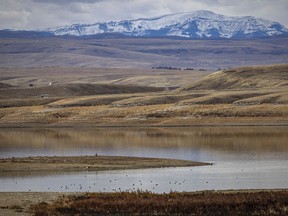
I saw ravens watching rough-legged hawks that were hunting along the fencelines and deer among the cottonwood flats along Willow Creek below the dam.
And there was still, surprisingly, a lot of bright green grass. Even more surprising, there were gophers nibbling on it.
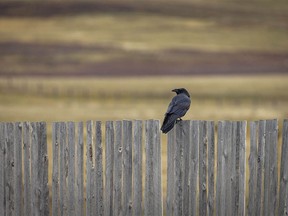
They, these Richardson’s ground squirrels, should have been tucked into their burrows for their winter sleep by now but nope, they were out and gobbling up the green like it was July. Chubby little things, they’ll have plenty of fat to tide them over once they do hit the sack.
Advertisement 7
Article content
I left the shrinking reservoir behind now and headed over to nearby Willow Creek Provincial Park where I had hoped to poke around among the cottonwoods for a bit. Unfortunately, the gate to the park was locked up tight. Why, I don’t know, but since it was shut, I kept on going south.
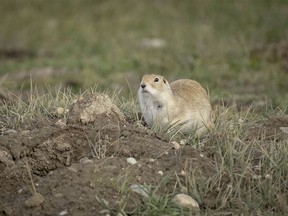
I found a pair of bald eagles in a tall cottonwood along Willow Creek — one of which was tearing apart a small bird — and managed to catch a whitetail doe in that split second before she ran off in an entirely unwarranted panic over in the Trout Creek valley. Down here, the chinook clouds were building up even more so I turned west again to watch them churn.
And as I did, I noticed a big glacial erratic out in a pasture.

I love these things, these chunks of quartzite carried here and dropped by glaciers 10,000 years ago but I don’t often stop to photograph them. This time, though, I had my little drone so I decided to launch it for a closer look.
Advertisement 8
Article content
Flying over it and looking down, it made me think of a big, stone bird sitting on a nest, the depression in the prairie around it scattered with rounded rocks that looked like eggs.

The wind was beginning to gust now so I flew the copter back and rolled on westward, stopping to photograph more boulders, big and small, as I went. Fascinating things, these erratics.
But the further west I went, the cloudier it became, the clouds casting shadows on the heights of the Porcupines and scooting patches of sunlight across the Trout Creek valley as the freshening wind pushed them along.

Down in the valley I found mule deer — much less flaky than their whitetail cousin I met earlier — munching on grass and then, closer to the high country, a good-sized flock of sheep doing the same. Above the ridges — where there were still patches of snow — I could see clouds ripping past stands of pine and spruce.
Advertisement 9
Article content
It was windy where I was down in the valley but nothing like it was up on the ridges, so after going up to the summit for a look, I turned around and came back down again. And noticed it was starting to get a bit dark.

The aspens and limber pines on the slopes were easy enough to photograph — I especially love the old, dead ones — but the light levels seemed pretty low. And glancing at the clock on my dashboard, I quickly figured out why.
For one thing, nice as the day was, it is still, after all, November. The equinox had passed nearly two months ago and the hours of daylight have been declining since then. The second thing is that, though I had reset the dash clock back to Mountain Standard Time, my head was still on Mountain Daylight Time.
Advertisement 10
Article content
As a result, I was thinking I had nearly two hours until sunset when, in fact, I barely had one. So I turned around and headed back down toward the open country again.
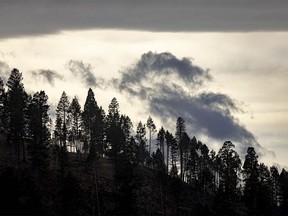
I took a side road along Trout Creek and flew the drone again for a quick look up the valley before rolling back across the boulder-pocked plains. Though still breezy, the wind out here was much less blustery than it had been in the hills and now that I was out from under the chinook clouds, everything was brighter, too.
Golden light swept in underneath the clouds and lit up cattle in pastures and contoured the slopes of the Porcupines with soft shadows. Flocks of geese flew over me on their way to Pine Coulee to settle in for the night and after watching the sun dip below the hills — at around 5 p.m., not 6 p.m. — I followed.
Advertisement 11
Article content
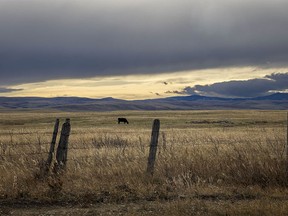
The reservoir was nearly as calm as it had been in the morning and the sun-blushed clouds reflected on its surface. The geese I had seen were out on the widest part but goldeneyes, coots and wigeons swam through the reflections in front of me.
I could hear them splashing as they dove, the lapping water mingling with the sound of cattle from up the coulee and the gabbling of geese from down below. And then the coyotes began to sing.
A lovely end to a lovely day.

Pine Coulee Reservoir is a man-made thing. It doesn’t belong here and, but for us, it wouldn’t exist at all.
But it does and in its way it’s actually quite beautiful. Especially in the evening light.
It needs water, though. As does everywhere else in southern Alberta. So let’s hope for mountain snow and spring rain.
And that Pine Coulee Reservoir rises again.

Article content
Comments
Postmedia is committed to maintaining a lively but civil forum for discussion and encourage all readers to share their views on our articles. Comments may take up to an hour for moderation before appearing on the site. We ask you to keep your comments relevant and respectful. We have enabled email notifications—you will now receive an email if you receive a reply to your comment, there is an update to a comment thread you follow or if a user you follow comments. Visit our Community Guidelines for more information and details on how to adjust your email settings.